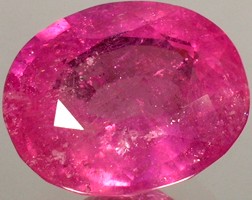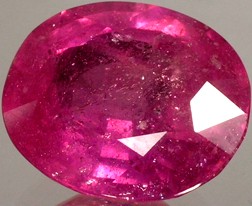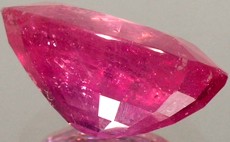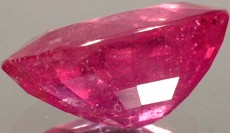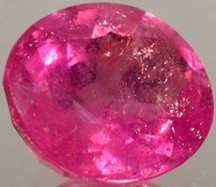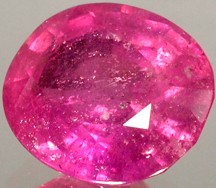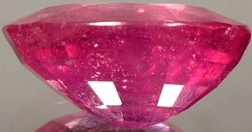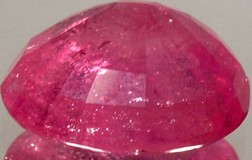|
For Customers outside of USA 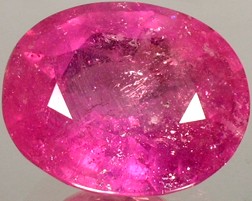
One Gorgeously Colored Handcrafted Antique Genuine Natural Faceted Eight and One-Quarter Carat (Plus) Neon Red-Orange-Pink Sapphire Oval Cut Precious Gemstone from Russia. ORIGIN: 19th Century Russia. SIZE: Length: 13mm. Width: 11mm. Depth: 6mm. Measurements approximate. WEIGHT: 8.22 carats. NOTES: Upon request we can set your gemstone as a ring, pendant, or as earrings.
DETAIL: A gorgeous, vibrantly colored natural red-orange-pink sapphire precious gemstone from the Southern Ural Mountains of Siberia, Russia. The gemstone was hand crafted and faceted by a 19th century Russian artisan, part of an heritage renown for the production of the elaborate gemstones and jewelry of the Czars of Medieval, Renaissance, and Victorian Russia. The color is absolutely magnificent; a bright, intense, almost neon red, with pink and orange/peach undertones. The color is popularly known as "padparadsha" red, and both the intense hue and the fiery sparkle are remarkable. The color is quite exquisite, the sparkle diamond-like in intensity. Hold the gemstone between thumb and finger and roll it, and the rolling, fiery red sparkle is mesmerizing.
This sparkling precious gemstone is transparent, near eye clean to the cursory glance of the casual admirer, or "lightly to modestly blemished" to scrutiny, with a highly desirable bright red-orange-pink color, vibrant character, and dazzling sparkles of fiery, brilliant bright red flashes. It is transparent as opposed to lower value translucent gemstones. However the gemstone is not anywhere near flawless, though to the casual admirer, it is to a cursory glance near eye clean. However if subjected to examination by anyone with even reasonably good vision, and they look closely at the gemstone from a distance of not more than a few inches, even without the aid of a jeweler's loupe, a very liberal scattering of very fine, sparkly blemishes may be picked out very easily with the unaided eye. Most of these scattered particles sparkle quite intensely when viewed from most angles. They appear to be mica schist particles (both sapphire and ruby are generally formed in schist). As would be suggested by the nature of "mica", some of these (almost microscopic) particles sparkle quite brightly. They are very small, almost invisible even to a 5x or 10x jeweler's loupe, but occasionally when viewed in a loupe, you will see a sparkle, if not the particle itself. Other particles are rutile schist, meaning that they appear under magnification look like short little pieces of finely stranded material, most individual, but some clumped together resembling through a jeweler's loupe like little pieces of dryer lint. Some of them look a little bit like horsetails for those who might be familiar with demantoid garnet. Again they are detectable with the naked eye if you scrutinize the gemstone closely.
All of this of course is observable with a jeweler's loupe, or in these 500% photo enlargements. To the cursory admiring glance of the casual admirer, the gemstone appears "near eye clean", or "modestly blemished" if one is inclined to be less generous. Of course most natural sapphire gemstones are anywhere from lightly to heavily included. Unfortunately most transparent "sapphires" sold even by the largest and most reputable retailers in the United States are synthetic (read the fine print; and the same is true of emeralds and rubies). While this particular specimen might not be anywhere near flawless, to the cursory glance of the casual admirer it is at least "near eye clean", and it is most assuredly not synthetic, and despite the blemishes, it is nonetheless a remarkable beautiful and vividly colored gemstone. While in these 500% photo enlargement these bits of rutile mica seem quite obvious, the blemishes this padparadsha sapphire does possess will be much more difficult to discern once the gemstone is set into a pendant or ring. As it is the only way to easily see these blemishes with the naked eye is to hold the gemstone up to a light source and scrutinize it carefully. Whatever sins the critic might find, to the eye of the casual admirer it is simply a bright red-orange-pink sapphire of gorgeous color, the dispersed, modest blemishes are not really immediately discerned by the naked eye, at least to the normal casual admirer, and the brightly colored gemstone possesses very handsome luster and really exceptional sparkle as well - lots of fire!
While this gorgeous precious gemstone is not absolutely flawless, it is most certainly toward the higher end of the quality spectrum. Under magnification the gemstone shows the unmistakable characteristics of having been hand crafted. The coarseness of the 19th century finish is considered appealing to most gemstone collectors, and is not considered a detriment, or detract from the value of a gemstone. These characteristics are not only expected of hand-finished gemstones, most serious collectors consider such gemstones more desirable, possessed of greater character and uniqueness when compared to today's cookie-cutter mass-produced machine-faceted gemstones. Unlike today's computer controlled machine produced gemstones, the cut and finish of a gemstone such as this is the legacy of an artisan who lived two centuries ago. This gemstone has great luster and color, superb sparkle, and to the eye is absolutely transparent. But again, of course, we want to emphasize that this does not mean it is entirely flawless. True, the blemishes it possesses are not easily discerned by the naked eye - at least to casual scrutiny. As stated, to casual scrutiny it is simply a brightly colored sapphire gemstone of wonderful color and sparkle. However in these 500% photo enlargements you can see some of the sparkly mica blemishes (both particulate and rutile), as well as occasional irregularities in the cut and finish. Naturally these characteristics are not only expected of hand-finished gemstones, you must also consider that two centuries ago the mining techniques even possible then, let alone in practice, did not allow the ultra deep mining operations which are so commonplace today.
Keep in mind that two centuries ago mankind was more or less limited to surface deposits or near surface deposits of gemstones. Higher quality gemstones which today are routinely mined from beneath hundreds of meters, even kilometers beneath the earth's surface, were simply inaccessible then. It is for this reason that antique gemstones must be appreciated as antiques first, gemstones second. The relatively superlative quality of contemporary gemstones routinely mined from deep beneath the earth's surface today were simply not accessible two centuries ago, or at least, only rarely so. However for most, the unique nature and character of antique gemstones such as this more than makes up for included imperfections which by and large, are only visible under magnification. HISTORY: Sapphires have been since ancient times one of the most highly valued of all gemstones, and references to the gemstone date back to about 800 B.C. The name "sapphire" comes from the Latin "sapphirus" and the Greek "sappheiros", which translates to "blue" in both languages. The name sapphire is also a derivative of the ancient Hebrew and Persian word for "blue" as well. To the ancient Romans however, the word "sapphirus" actually referred to lapis lazuli, another blue gemstone. What the Romans called blue sapphire translates to "hyacinth"; the green sapphire was "emerald", and the purple sapphire was "amethyst". In the ancient Mediterranean world, priests and sorcerers honored the sapphire above all other gems. They believed that the sapphire enabled them to interpret oracles and foretell the future.
The ancient Persians believed that the earth rested on an enormous sapphire, and the sky reflected its beautiful color. They referred to the sapphire as "the gem of the heavens". As the centuries passed, European royalty came to favor sapphire believing the stone would provide protection from harm. Throughout Medieval Europe, the sapphire was thought to give the wearer strengthened vision, including visions of the future. Sapphire was regarded as an antidote to black magic and effects of evil spirits. It was held to be a symbol of truth and constancy. Sapphires are a member of the corundum family, and close relative to the ruby. In fact, a ruby is simply a red sapphire. The sapphire is considered one of the most valuable of precious stones. The principal sources of sapphire in modern history are Russia, Siam, Ceylon, Burma, Africa, and Australia.
SHIPPING OPTIONS: All purchases are backed by an unlimited guarantee of satisfaction and authenticity. If for any reason you are not entirely satisfied with your purchase, you may return it for a complete and immediate refund of your entire purchase price. Most of these antique gemstones were originally part of two collections, one originating in India principally composed of gemstones originally mined in India, Burma, Ceylon, and Siam, and then hand faceted in India. The addition of a second accumulation of antique gemstones originally mined in the Urals in the mid to late 19th century (including alexandrite) completed the collection. These gemstones as well were hand finished. The Urals have been one of the world's major sources of precious and semi-precious gemstones for many centuries. As well, additional specimens are occasionally acquired from other institutions and dealers in Eastern Europe and Asia. These antique gemstones are now in the United States and are available for immediate delivery. We ship inventory from the USA order fulfillment center near Seattle, Washington. Your purchase will ordinarily be shipping within 48 hours of payment. A certificate of authenticity is available upon request. We prefer your personal check or money order over any other form of payment - and we will ship immediately upon receipt of your check (no "holds"). We will accept PayPal payments. Please see our "ADDITIONAL TERMS OF SALE".
|
|---|
